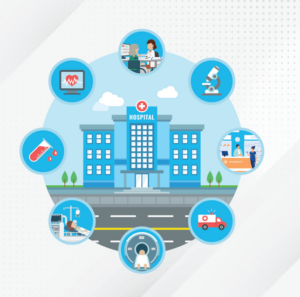The Rise of the IDN: Healthcare Reimagined for a New Era

 The American healthcare landscape has undergone a dramatic shift since the founding days of our nation. A far cry from the US’ first hospital established in 1751 by Benjamin Franklin and Dr. Thomas Bond – Pennsylvania Hospital – the landscape is now dominated by a complex network of healthcare providers. Gone are the days of the small, local clinic or the trusted neighborhood physician as the sole providers of medical care. In their place, a new model has emerged – the Integrated Delivery Network (IDN).
The American healthcare landscape has undergone a dramatic shift since the founding days of our nation. A far cry from the US’ first hospital established in 1751 by Benjamin Franklin and Dr. Thomas Bond – Pennsylvania Hospital – the landscape is now dominated by a complex network of healthcare providers. Gone are the days of the small, local clinic or the trusted neighborhood physician as the sole providers of medical care. In their place, a new model has emerged – the Integrated Delivery Network (IDN).
This sector is experiencing explosive growth, with the U.S. IDN market size valued at a staggering $1.2 trillion in 2023 and projected to reach a colossal $2.3 trillion by 2033. This phenomenal growth, representing a compound annual growth rate (CAGR) of over 7.5%, underscores the dominance of IDNs in shaping the future of healthcare delivery. As these vast networks encompass a significant portion (67%) of the healthcare market, understanding their impact and optimizing communication within them is crucial.
Consolidation Generates Colossal Care Systems – The Ups and The Downs:
IDNs are vast healthcare networks that encompass hospitals, physician practices, specialists, and other healthcare entities under a single umbrella. This consolidation allows for centralized management, economies of scale, and often, enhanced patient care options.
Furthermore, IDNs play a pivotal role in standardizing patient care across their networks. By developing and implementing consistent protocols, these organizations can ensure a more uniform and predictable experience for patients, regardless of the specific facility or provider they interact with.
Finally, IDNs often possess greater resources to invest in research and development. This enables them to stay at the forefront of medical advancements, offering patients access to innovative treatments and technologies.
While IDNs offer numerous benefits, they also present certain challenges. One potential drawback is a reduction in patient choice. As IDNs consolidate healthcare services, patients may have fewer options for providers within their network.
Additionally, large organizations can be susceptible to bureaucratic procedures, which can sometimes hinder efficient care delivery. The sheer size and complexity of IDNs can introduce layers of bureaucracy that can slow down decision-making processes and create administrative burdens.
Some patients may feel a loss of personal touch within the IDN model. The large-scale nature of these organizations can sometimes lead to a sense of depersonalization, as patients may feel like just one of many in a vast system.
The Cornerstone of Success in a Complex Healthcare Landscape
Effective communication is the cornerstone of success in the sprawling landscape of IDNs. To navigate the complexities of managing vast healthcare networks, IDNs must prioritize streamlined information exchange and efficient workflows. This is where unified mobility solutions, such as HODs (healthcare-optimized devices), come into play.
HODs revolutionize IDNs by merging multiple devices into a single, rugged solution that reduces the need for various tech types, expensive cases, and frequent replacements—cutting overall costs and saving valuable time across all locations. An integrated barcode scanner eliminates additional expensive scanning device sleds, further saving expenses.
HODs feature high processing power and large touchscreens, ensuring compatibility with essential applications like EHRs and Nurse Call systems. This streamlines IT operations and enhances user experience, leading to a productive work environment, improved patient outcomes, and a healthier bottom line all while saving precious time.
Also, the healthcare sector is a prime target for cyberattacks, and data breaches can be devastating for IDNs, costing the healthcare industry a staggering $9.3 million per breach on average. HODs offer robust security that safeguards sensitive patient data. Advanced encryption protects information at rest and in transit, while regular software updates that can be deployed across the IDN at one time ensure the latest security patches are applied.
This all translates to a more efficient, secure, and cost-effective healthcare environment for your entire network, making HODs a strategic investment for IDNs.
Spectralink HODs: The Trusted Partner for IDNs
Spectralink’s Versity 97 is more than just a smartphone; it’s a healthcare-optimized device designed to meet the unique demands of IDNs. As a testament to its capabilities, Spectralink equips many of the top IDNs in the US!
Like these IDNs and many healthcare organizations worldwide, you can trust that your Versity 97 devices will perform when you need them most. Rigorously tested and validated with essential healthcare applications, Versity ensures seamless communication and empowers staff across your entire IDN to deliver exceptional patient care.
Ready to Experience Superior Healthcare, Faster?
Don’t wait to experience the transformative power of Spectralink HODs. Contact Spectralink’s clinical workflow experts today to schedule a demo and discover how our solutions can help your IDN achieve operational excellence, enhance communication, and ultimately deliver superior patient care – faster.
